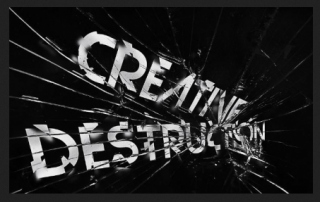Violence and creativity are part of our everyday global experiences. From the massacres to the cartoons we are surrounded by both, and though inevitably we experience these elements of life individually, is there a clear relationship between violence, creativity and us?

Violence in life from bombing towns and villages, sexual abuse, rites of passage, female genital mutilation, and school massacres to bullying can be found throughout all human history, and communities. The decline of violence in some societies in the last hundred years gives us some hope that perhaps fewer and fewer human beings will suffer the consequences as we move forward in time. However, where does creativity fit in this reduction of violence, and how does violence influence creativity?
Creative expressions of violence
Our histories are littered with creative expressions of recording, or reacting, to violence and those who participate in it. These range from recordings of pre-historic cave art to the numerous celebratory examples of triumphal columns, arches, and statues http://whc.unesco.org/pg.cfm?cid=31&id_site=441 . These have often been seen as a celebrations of violence but we have also reacted against it as in the war poets after the First World War http://www.warpoetry.co.uk/FWW_index.html, and more recently http://poetsagainstthewar.org/content/global-movement-poets.
Equally, the creative depictions of violence have been central to most human cultures. These have ranged from Assyrian bas reliefs of war https://clioantiquities.files.wordpress.com/2014/10/img_1870.jpg to murders, for example David’s The death of Marat http://the-paintrist.tumblr.com/post/29330226762/jacques-louis-david-the-death-of-marat-1793 to contemporary violence in Mexico in Elvira Santamaria Torres’ Red Flux http://elvirasantamariatorres.co.uk/wp-content/uploads/2013/05/Red-Flux-2012.jpg
Clearly with this range of activities violence can play a central part in creative expression.
Violence as a creative solution
However, most people now do not relate to bas reliefs, wall paints, or even painting, and performance art, but to films, television, and games. It is these screen media that provide the modern expression of violence for most people. In this context violence is seen and used predominantly as a means of creating a climax to a narrative.
The dominance of violence as a cinematic experience is clearly seen in the global top ten films of 2014, https://www.youtube.com/watch?v=cubWUCSw2kk. This ranges from Guardians of the Galaxy’ and ‘The Hobbit: The Battle of the Five Armies’ in cinemas in the last twelve months to ‘Kung Fu Panda’ and ‘Snow White and The Huntsman’ in the recent past. In console games, ‘shoot-em up’, and violent senarios, still dominate http://www.onlinenewspoint.com/top-10-most-popular-console-games-in-2014/. Even within TV drama, often seen as a more conservative, less violent space, murder is at the heart of all detective series and violence dominates many drama series from the ‘Sopranos’ to ‘Game of Thrones’.
The reason for this dominant use of violence in screen narratives, is fairly obvious. It provides an illusion of closure i.e. of an ending for the particular narrative. We know people will want at some point to stop watching the output of anyone’s creativity. The use of violence, often leading to death, offers an easy option to achieve this moment of disengagement.
When it comes to games and cinematic experiences it also provides an obvious means of creating fast-action based, spectacle. An experience, which can be engaged in without any specific linguistic skills or historical knowledge. So clearly creatives will use violence for narrative purposes, whether this be defined as ‘cartoonish’ or ‘realistic’.
The difference between creative expression and violent reality.
In our everyday lives though there is a huge difference between these creative expressions of violence and the reality of it. It is hard to imagine when you are faced with bombing, torture, the threat of beatings, or live with a history of personal violent encounters that creativity will thrive in this moment. In the aftermath of violence, of course, creativity has often thrived – see most of the examples above, but in our everyday lives violence suppresses creativity and provides yet another illusion closure.
Those who use violence want something to end, and killing, or beating others up, appears to offer this solution. However, humanity does not end with a death, tens of thousands deaths, or millions of deaths as the genocidal acts of the Twentieth Century demonstrated. Killing anyone obviously ends their life, continually inflicting violence on a community will generate a silence, out of fear. These events may apparently benefit a few in the short term but as a community we suffer and our creativity suffers as a consequence.
Defending or creating space to be creative
It is in this context that creativity is so antithetical to violence. Violence is about destruction. Creativity is the opposite. Creativity may involve destruction in its process but its goal is the creation of something new which represents something we care about, not the destruction of someone or something we are scared of. To be creative we need a space free of violence in which to create, and those who use violence need to be resisted by all who wish to be creative. It is in the space free of violence we share our experience and understand each others means of expression.
